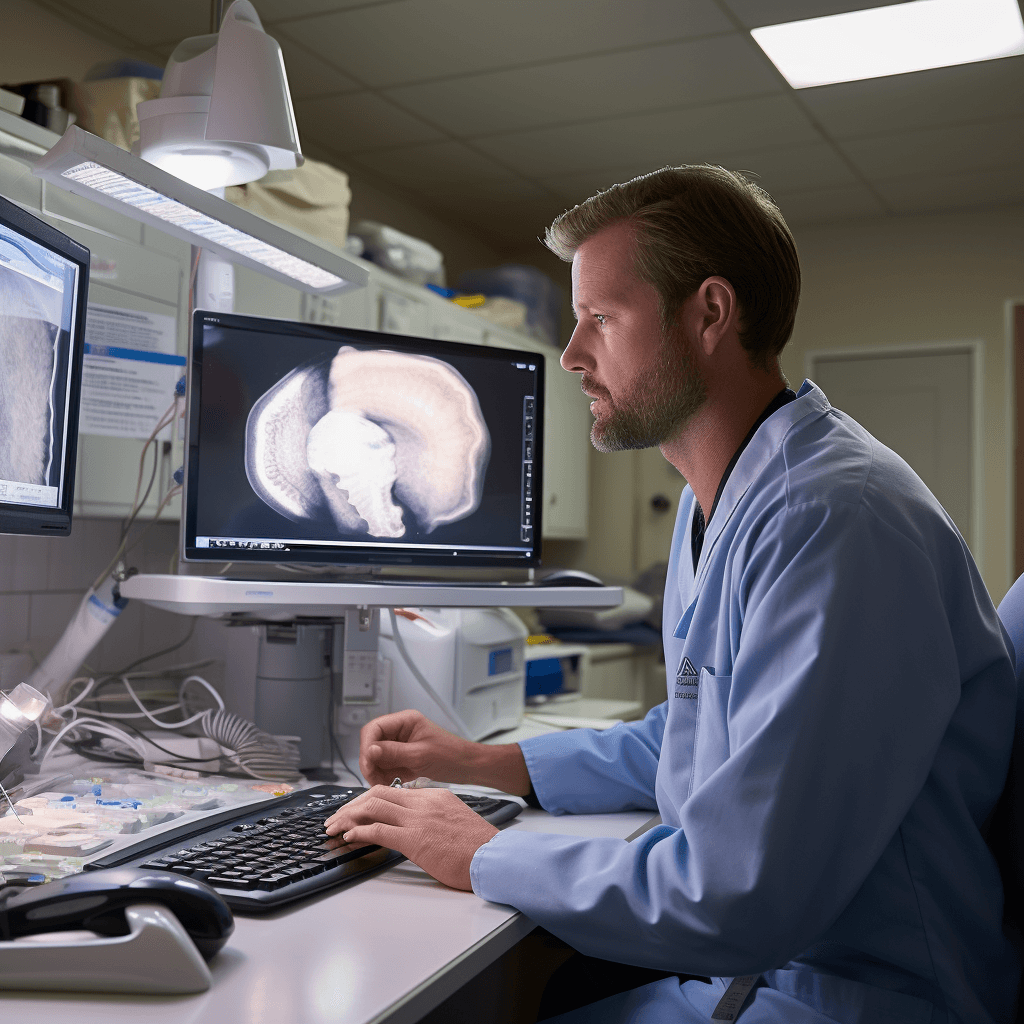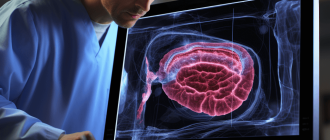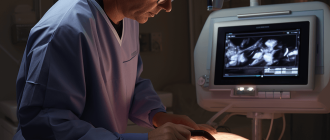 What is the Upper GI Barium Swallow Test and why is it necessary?
What is the Upper GI Barium Swallow Test and why is it necessary?
The Upper GI Barium Swallow Test is a diagnostic procedure that is used to examine the upper gastrointestinal (GI) tract. This includes the esophagus, stomach, and the first part of the small intestine called the duodenum. The test involves the use of a contrast material called barium, which is swallowed by the patient. The barium coats the lining of the GI tract, making it visible on X-ray images.
This test is typically performed to evaluate and diagnose various conditions affecting the upper GI tract, such as gastroesophageal reflux disease (GERD), hiatal hernia, peptic ulcers, and swallowing difficulties. It can also help detect abnormalities, such as strictures or blockages, tumors, and inflammation. The Upper GI Barium Swallow Test provides detailed images of the structures and function of the upper GI tract, allowing healthcare professionals to make accurate diagnoses and develop appropriate treatment plans.
During the procedure, the patient will be asked to drink a liquid containing barium. The barium coats the lining of the esophagus, stomach, and duodenum, making them visible on X-ray images. X-ray images will be taken at different times to capture the movement of the barium through the GI tract. In some cases, additional imaging techniques, such as fluoroscopy, may be used to obtain real-time images of the barium as it passes through the digestive system.
The Upper GI Barium Swallow Test is a safe and relatively non-invasive procedure that provides valuable information about the upper GI tract. It is an important tool in the diagnosis and management of various GI conditions. If you are experiencing symptoms such as persistent heartburn, difficulty swallowing, or unexplained weight loss, your healthcare provider may recommend an Upper GI Barium Swallow Test to help determine the underlying cause and develop an appropriate treatment plan.
What is an Upper GI Barium Swallow Test?
An Upper GI Barium Swallow Test, also known as an Upper Gastrointestinal Series or Barium Meal, is a diagnostic procedure that allows doctors to examine the upper gastrointestinal (GI) tract, which includes the esophagus, stomach, and small intestine. It involves drinking a liquid called barium, which coats the lining of the GI tract and makes it visible on X-ray images.
The test is typically performed to diagnose various conditions such as ulcers, tumors, strictures (narrowing), and abnormalities in the esophagus, stomach, or small intestine. It can also help evaluate symptoms such as difficulty swallowing, heartburn, chest pain, and unexplained weight loss.
During the procedure, the patient is asked to drink a chalky white liquid containing barium sulfate. The barium coats the lining of the upper GI tract, allowing the radiologist to take X-ray images as the barium passes through the esophagus, stomach, and small intestine. These images can help identify any abnormalities or problems in the GI tract.
The test is generally safe and well-tolerated, although some patients may experience temporary discomfort or bloating from the barium. It is important to follow any preparation instructions given by the healthcare provider, such as fasting for a certain period of time before the test.
In some cases, additional imaging techniques such as fluoroscopy or ultrasound may be used during the procedure to obtain more detailed information about the GI tract.
| Benefits | Risks |
|
|
Overall, the Upper GI Barium Swallow Test is a valuable diagnostic tool that allows doctors to visualize and evaluate the upper GI tract. It can provide important information for diagnosing and treating various GI conditions, helping patients receive appropriate care.
Definition
The Upper GI Barium Swallow Test, also known as an upper gastrointestinal series or barium swallow test, is a diagnostic procedure that involves taking X-ray images of the upper gastrointestinal tract. It is used to evaluate the structure and function of the esophagus, stomach, and small intestine. During the test, the patient swallows a contrast material called barium, which coats the lining of the digestive tract and makes it visible on X-ray images.
How It Works
The upper GI barium swallow test is a diagnostic procedure that allows doctors to examine the upper gastrointestinal tract, including the esophagus, stomach, and small intestine. The procedure involves drinking a liquid called barium, which coats the lining of the organs and makes them visible on X-ray images.
During the test, the patient is asked to swallow small sips of the barium liquid while standing in front of an X-ray machine. The barium flows through the esophagus into the stomach and then into the small intestine. The X-ray machine takes a series of images as the barium passes through the digestive system.
The images captured during the test can help doctors identify abnormalities or problems in the upper gastrointestinal tract, such as narrowing of the esophagus, ulcers, tumors, or blockages. The test can also help evaluate the functioning of the muscles and valves in the digestive system.
After the procedure, the barium may cause temporary changes in bowel movements, such as constipation or white stools. It is important to drink plenty of fluids and eat a high-fiber diet to help the body eliminate the barium.
| Advantages | Disadvantages |
| – Non-invasive procedure | – Exposes the patient to radiation |
| – Provides detailed images of the upper GI tract | – Potential allergic reaction to barium |
| – Can help diagnose various conditions | – Requires fasting before the test |
Conditions It Can Detect
The upper GI barium swallow test is a diagnostic procedure that can detect various conditions in the upper gastrointestinal tract. Some of the conditions that can be detected include:
| Condition | Description |
| Gastroesophageal reflux disease (GERD) | A condition where stomach acid flows back into the esophagus, causing symptoms such as heartburn and acid regurgitation. |
| Hiatal hernia | A condition where a portion of the stomach protrudes into the chest cavity through the diaphragm. |
| Esophageal strictures | Narrowing of the esophagus, often caused by inflammation or scarring. |
| Tumors or polyps | Abnormal growths in the gastrointestinal tract that can be benign or malignant. |
| Dysphagia | Difficulty swallowing, often caused by a blockage or narrowing in the esophagus. |
| Esophageal motility disorders | Conditions that affect the movement and coordination of the muscles in the esophagus, leading to swallowing difficulties. |
The upper GI barium swallow test is a valuable tool in diagnosing these conditions and can help guide further treatment options.
Why Is an Upper GI Series Done?
An upper gastrointestinal (GI) series, also known as a barium swallow test, is a diagnostic procedure that is used to examine the esophagus, stomach, and small intestine. It is performed to identify any abnormalities or conditions in these areas.
The test is typically done to evaluate symptoms such as difficulty swallowing, abdominal pain, reflux, or unexplained weight loss. It can help diagnose a variety of conditions including gastroesophageal reflux disease (GERD), hiatal hernia, ulcers, tumors, or strictures.
During the procedure, the patient drinks a liquid called barium, which coats the lining of the esophagus, stomach, and small intestine. X-ray images are then taken to visualize the barium as it moves through the digestive system. These images can reveal any abnormalities or blockages that may be present.
An upper GI series is a non-invasive and relatively safe procedure. It does not require anesthesia and can usually be completed within one to two hours. However, it is important for patients to follow any preparation instructions provided by their healthcare provider, such as fasting before the test.
If you are experiencing symptoms that may indicate a problem in your upper digestive system, your healthcare provider may recommend an upper GI series. It can provide valuable information to help diagnose and treat your condition. It is important to discuss any concerns or questions you may have with your healthcare provider before undergoing the test.
| Benefits of an Upper GI Series | Risks of an Upper GI Series |
|
|
Main Uses
The upper GI barium swallow test is primarily used to diagnose conditions affecting the upper gastrointestinal tract. Some of the main uses of the test include:
- Evaluating the structure and function of the esophagus: The test can help identify any abnormalities or narrowing in the esophagus, such as strictures or tumors.
- Detecting gastroesophageal reflux disease (GERD): This condition occurs when stomach acid flows back into the esophagus, causing symptoms like heartburn. The barium swallow test can show if there is any backward flow of stomach contents into the esophagus.
- Diagnosing hiatal hernias: A hiatal hernia is a condition in which a portion of the stomach pushes up through the diaphragm into the chest cavity. The test can help visualize and determine the size of the hernia.
- Identifying swallowing difficulties: The test can assess the coordination and function of the muscles involved in swallowing. It can help diagnose conditions like dysphagia, where there is difficulty swallowing.
- Detecting ulcers or other abnormalities in the stomach or duodenum: The test can reveal any abnormalities, such as ulcers, tumors, or inflammation in the stomach or the first part of the small intestine (duodenum).
Overall, the upper GI barium swallow test is a valuable diagnostic tool that can provide important information about the structure and function of the upper gastrointestinal tract.
Advantages Over Other Tests
The upper GI barium swallow test offers several advantages over other tests used to diagnose conditions of the upper gastrointestinal tract.
Here are some of the key advantages:
| Non-invasive: | The barium swallow test is a non-invasive procedure, meaning it does not require any incisions or punctures. This makes it a safer and less uncomfortable option compared to invasive tests such as endoscopy or surgery. |
| Wide coverage: | The barium swallow test allows for a comprehensive evaluation of the entire upper gastrointestinal tract, including the esophagus, stomach, and duodenum. This provides a more complete picture of any abnormalities or conditions present. |
| Real-time imaging: | During the barium swallow test, the patient is able to see the real-time movement of the barium contrast material as it passes through the digestive system. This allows for immediate visualization of any structural or functional abnormalities. |
| Cost-effective: | Compared to other imaging tests such as CT scans or MRI scans, the barium swallow test is generally more cost-effective. It can provide valuable diagnostic information without the need for expensive equipment or lengthy procedures. |
| Minimal preparation: | Prior to the barium swallow test, patients typically only need to fast for a few hours. This is in contrast to other tests that may require more extensive preparation, such as fasting for longer periods or undergoing bowel cleansing. |
Overall, the upper GI barium swallow test offers a safe, comprehensive, and cost-effective option for diagnosing conditions of the upper gastrointestinal tract. Its non-invasive nature and real-time imaging capabilities make it a valuable tool in the field of gastroenterology.
Limitations
The upper GI barium swallow test has several limitations that should be considered. First, it is a static test, meaning that it only provides a snapshot of the esophagus, stomach, and small intestine at a specific moment in time. This means that it may not detect any abnormalities that are not present during the test.
Additionally, the test relies on the patient’s ability to swallow and cooperate during the procedure. Some patients may find it difficult to swallow the barium solution or maintain the required positions during the test, which can affect the accuracy of the results.
Furthermore, the test may not be able to detect certain conditions or abnormalities, such as small ulcers or early stages of cancer. In these cases, additional tests may be necessary to make a definitive diagnosis.
It is also important to note that the upper GI barium swallow test exposes the patient to ionizing radiation. While the amount of radiation is relatively low, pregnant women and individuals who may be sensitive to radiation should inform their healthcare provider before undergoing the test.
Finally, the interpretation of the test results is subjective and depends on the expertise of the radiologist. Different radiologists may have different interpretations, which can lead to inconsistencies in diagnosis.
Limitations:
| – Static test |
| – Dependence on patient cooperation |
| – Inability to detect certain conditions |
| – Exposure to ionizing radiation |
| – Subjective interpretation of results |
How to Prepare for an Upper GI Series
Before undergoing an upper GI series, it is important to follow certain preparations to ensure accurate results. Here are some steps to help you prepare for the procedure:
- Discuss your medical history: Inform your healthcare provider about any previous medical conditions, allergies, or surgeries you have had. This information is crucial for the safe administration of the test.
- Fasting: You will be required to fast for a certain period of time before the test. Typically, this means not eating or drinking anything after midnight the night before the procedure. Your healthcare provider will provide specific instructions regarding fasting.
- Medication adjustments: Inform your healthcare provider about any medications you are currently taking. Some medications may need to be temporarily stopped or adjusted before the test. Follow your healthcare provider’s instructions regarding medication management.
- Avoiding gum or candy: Chewing gum or eating candy can interfere with the test results. Avoid these items before the procedure.
- Dress comfortably: Wear loose-fitting clothing that is easy to remove. You may be asked to change into a hospital gown for the test.
- Remove jewelry and accessories: Before the procedure, remove any jewelry, piercings, or accessories that may interfere with the test or cause discomfort.
- Arrive on time: Make sure to arrive at the testing facility on time. The procedure may take a couple of hours, so plan your schedule accordingly.
- Ask questions: If you have any concerns or questions about the procedure, do not hesitate to ask your healthcare provider. It is important to fully understand what to expect and to address any concerns beforehand.
By following these preparation steps, you can ensure a smooth and successful upper GI series. It is important to adhere to the instructions provided by your healthcare provider for accurate results.
Fasting Instructions
Before undergoing an upper GI barium swallow test, it is important to follow fasting instructions to ensure accurate results. Fasting means avoiding food and drink for a certain period of time before the test. The fasting period helps to empty the stomach and provide a clear view of the upper gastrointestinal tract.
General fasting instructions:
- Do not eat or drink anything after midnight the night before the test.
- Avoid chewing gum, mints, or any other form of food or drink during the fasting period.
- Inform your healthcare provider about any medication you are taking, as some may need to be temporarily stopped before the test.
- If you are diabetic, discuss fasting instructions with your healthcare provider to ensure proper management of your blood sugar levels.
Why is fasting necessary?
Fasting is necessary for an upper GI barium swallow test because it allows the barium contrast material to coat the lining of the esophagus, stomach, and small intestine without interference from food particles. Food in the stomach can obstruct the view and may lead to inaccurate results. Fasting also reduces the risk of aspiration, which is inhaling food or liquid into the lungs during the test.
Note: Always follow the specific fasting instructions provided by your healthcare provider. These instructions may vary depending on your individual circumstances and the specific requirements of the test.
Medication Adjustments
During an upper GI barium swallow test, it is important to inform your healthcare provider about any medications you are currently taking. Certain medications may interfere with the test or affect the results. Your healthcare provider may ask you to make some adjustments to your medication routine before the test. These adjustments may include:
| Medication | Adjustment |
| Antacids | You may be asked to stop taking antacids for a period of time before the test, as they can affect the visibility of the esophagus and stomach on the X-ray. |
| Proton pump inhibitors (PPIs) | Your healthcare provider may ask you to stop taking PPIs for a certain period before the test, as they can reduce the production of stomach acid, which is necessary for the barium to move through the digestive system. |
| Medications that slow down digestion | If you are taking medications that slow down digestion, such as opioids or certain anticholinergic drugs, your healthcare provider may ask you to temporarily discontinue them before the test. These medications can affect the movement of the barium through the digestive system. |
| Other medications | Your healthcare provider may also ask you to make adjustments to other medications you are taking, depending on their potential impact on the test. |
It is important to follow your healthcare provider’s instructions regarding medication adjustments before the upper GI barium swallow test. This will help ensure accurate results and a successful test procedure.
What to Tell the Technologist
Before your upper GI barium swallow test, it’s important to communicate any relevant information to the technologist. This helps ensure the test is conducted safely and effectively. Here are some things you should tell the technologist:
| Medical History: | Inform the technologist about any past medical conditions, surgeries, or allergies you may have. It’s particularly important to mention any previous issues with your esophagus, stomach, or intestines. |
| Medications: | Provide a list of all the medications you are currently taking, including prescription drugs, over-the-counter medications, and supplements. Some medications may interfere with the test or require special precautions. |
| Pregnancy: | If there is a chance you could be pregnant, it’s important to let the technologist know. Radiation exposure during pregnancy can be harmful to the fetus. |
| Allergies: | If you have any known allergies, especially to barium or iodine, inform the technologist. This allows them to take appropriate measures to prevent any adverse reactions. |
| Previous Tests: | If you have had any previous imaging tests or procedures related to your digestive system, let the technologist know. This information helps them compare the current results with previous findings. |
| Current Symptoms: | Describe any symptoms you are experiencing, such as difficulty swallowing, heartburn, or abdominal pain. This information helps the technologist focus on specific areas during the test. |
By providing accurate and complete information to the technologist, you can help ensure the upper GI barium swallow test is performed safely and effectively. Don’t hesitate to ask any questions or express any concerns you may have before the test begins.
What to Expect During the Upper GI X-ray
During the upper gastrointestinal (GI) X-ray, you can expect the following:
1. Preparation: Before the procedure, you may be asked to fast for a certain period of time, usually overnight. This is to ensure that your stomach is empty, allowing for better visualization during the X-ray.
2. Changing into a gown: You will be given a gown to change into before the procedure. This is to ensure that there are no clothing or accessories that may interfere with the X-ray images.
3. Drinking the barium solution: The X-ray technician will provide you with a solution containing barium, which is a contrast material. You will be asked to drink this solution, which helps to highlight the structures of the upper GI tract on the X-ray images.
4. X-ray imaging: Once the barium solution is ingested, you will be positioned on an X-ray table. The technician will take a series of X-ray images as the barium travels through your upper GI tract. You may be asked to change positions or hold your breath during certain images to obtain the best possible views.
5. Side effects: It is normal to feel full or bloated after drinking the barium solution. You may also experience mild constipation or have white-colored stools for a few days following the procedure. These side effects are temporary and should resolve on their own.
6. Duration: The upper GI X-ray typically takes about 30 minutes to complete. However, the duration may vary depending on the individual and the specific requirements of the procedure.
7. Post-procedure instructions: After the X-ray, you may be given specific instructions by your healthcare provider. This may include drinking plenty of fluids to help flush out the barium from your system and resuming your regular diet, unless otherwise instructed.
Overall, the upper GI X-ray is a safe and non-invasive procedure that provides valuable information about the functioning and structure of the upper GI tract. By knowing what to expect during the procedure, you can feel more prepared and at ease when undergoing this diagnostic test.
Overview of the Procedure
The upper GI barium swallow test is a diagnostic procedure used to evaluate the upper gastrointestinal tract, which includes the esophagus, stomach, and the first part of the small intestine. It involves the use of a contrast medium called barium, which is a white liquid that helps to highlight the structures in the digestive system during X-ray examination.
During the procedure, the patient is asked to drink a barium solution, which coats the lining of the upper GI tract. X-ray images are then taken as the patient swallows the barium, allowing the radiologist to observe the movement of the liquid through the esophagus, stomach, and small intestine. This helps to identify any abnormalities or functional problems, such as strictures, ulcers, hiatal hernias, or swallowing difficulties.
The upper GI barium swallow test is a non-invasive and relatively safe procedure that provides valuable information about the structure and function of the upper digestive system. It is often used to diagnose conditions such as gastroesophageal reflux disease (GERD), peptic ulcers, esophageal strictures, and tumors. The test can help guide further treatment decisions and monitor the effectiveness of interventions.
Before the procedure, the healthcare provider will provide instructions on how to prepare, which may include fasting for a certain period of time. It is important to inform the healthcare provider of any allergies or medical conditions, as well as any medications being taken. During the procedure, the patient may be asked to change positions and swallow the barium at different rates to obtain clear images of the upper GI tract.
The upper GI barium swallow test typically takes about 30 minutes to an hour to complete. After the procedure, the patient may experience temporary discomfort, such as bloating or constipation, due to the barium. Drinking plenty of fluids and eating a high-fiber diet can help alleviate these symptoms. The X-ray images will be reviewed by a radiologist, who will then communicate the findings to the healthcare provider.
The upper GI barium swallow test is a valuable diagnostic tool that allows healthcare providers to visualize and evaluate the upper gastrointestinal tract. It is a safe and effective procedure that can help diagnose and monitor a variety of conditions affecting the digestive system.
Barium Swallowing
Barium swallowing, also known as an upper GI barium swallow test, is a diagnostic procedure used to examine the upper gastrointestinal (GI) tract. It involves the ingestion of a barium solution, a contrast medium that helps highlight the structures of the GI tract on X-ray images.
During a barium swallow test, the patient is asked to drink a liquid containing barium sulfate. As the barium flows through the esophagus, stomach, and small intestine, X-ray images are taken to visualize the movement of the barium and detect any abnormalities or blockages in the GI tract.
This test is commonly used to diagnose conditions such as gastroesophageal reflux disease (GERD), hiatal hernias, peptic ulcers, esophageal strictures, and swallowing disorders. It can also help identify tumors, polyps, and other abnormalities in the GI tract.
Barium swallowing is a safe and relatively non-invasive procedure. It is usually performed in a radiology department by a radiologist or a radiology technologist. The patient may be asked to swallow different consistencies of barium, such as liquid or paste, to evaluate the function and structure of the GI tract under different conditions.
Prior to the test, the patient may be asked to fast for a certain period of time to ensure accurate imaging results. After the procedure, it is important to drink plenty of fluids to help eliminate the barium from the body.
Barium swallowing is a diagnostic test that uses barium solution and X-ray imaging to examine the upper GI tract and detect abnormalities or disorders. It plays a crucial role in the diagnosis and management of various GI conditions, allowing healthcare professionals to provide appropriate treatment options for patients.
Possible Sensations
During an upper GI barium swallow test, you may experience a range of sensations. It is important to note that these sensations are normal and temporary. Some possible sensations you may experience include:
1. A fullness or bloating sensation: As the barium solution fills your stomach and intestines, you may feel a sense of fullness or bloating. This is a normal sensation and should subside after the test.
2. A metallic taste: Some patients may notice a metallic taste in their mouth as the barium solution is swallowed. This taste is harmless and will go away once the test is complete.
3. A warm or cool sensation: The barium solution may be at room temperature or slightly warmed before being ingested. You may feel a warm or cool sensation as the liquid passes through your digestive system.
4. A mild discomfort or pressure: As the barium fills your digestive tract, you may feel a mild discomfort or pressure. This is normal and should not cause any significant pain or distress.
5. The urge to burp or pass gas: The barium solution may cause you to feel the need to burp or pass gas. This is a normal response and can help to move the barium through your digestive system.
6. The need to swallow: Throughout the test, you may be asked to swallow multiple times to ensure that the barium solution reaches all areas of your upper GI tract. This is a normal part of the procedure.
It is important to communicate any discomfort or concerns you may have during the test to the healthcare professional performing the procedure. They can help to address any issues and ensure your comfort throughout the examination.
Understanding the Results of an Upper GI Series
After undergoing an upper GI barium swallow test, it is important to understand the results in order to assess your digestive health. The test provides valuable information about the structure and function of your upper gastrointestinal (GI) tract.
The results of an upper GI series can reveal a variety of conditions and abnormalities, such as:
1. Esophageal abnormalities: The test can identify any narrowing, inflammation, or tumors in the esophagus. This information is crucial for diagnosing conditions like gastroesophageal reflux disease (GERD) or esophageal cancer.
2. Hiatal hernia: An upper GI series can detect the presence of a hiatal hernia, which occurs when a portion of the stomach protrudes into the chest cavity through the diaphragm. This condition can lead to symptoms such as heartburn and difficulty swallowing.
3. Gastric ulcers: The test can uncover the presence of gastric ulcers, which are open sores in the lining of the stomach. These ulcers can cause pain, bloating, and other digestive symptoms.
4. Gastric motility disorders: An upper GI series can evaluate the movement and function of the stomach, helping to diagnose motility disorders such as gastroparesis or dumping syndrome.
5. Malformations or obstructions: The test can identify any structural abnormalities or blockages in the upper GI tract, such as strictures or tumors. These findings are important for diagnosing conditions like Crohn’s disease or stomach cancer.
It is important to consult with your healthcare provider to understand the specific implications of your upper GI series results. They will be able to interpret the findings in the context of your symptoms and medical history, and recommend appropriate treatment or further testing if necessary.
Remember, the results of an upper GI series are just one piece of the puzzle in diagnosing and managing digestive conditions. Open communication with your healthcare provider is key to developing an effective treatment plan and maintaining your digestive health.
Radiologist Interpretation
After the upper GI barium swallow test, the results are sent to a radiologist for interpretation. The radiologist is a specialized doctor who is trained to read and interpret medical images, such as X-rays and barium swallow images.
The radiologist carefully reviews the images taken during the test to look for any abnormalities or signs of disease. They pay close attention to the structure and function of the esophagus, stomach, and small intestine. They may also evaluate the movement of the barium as it passes through the digestive tract.
Based on their interpretation, the radiologist will provide a detailed report to the referring physician. This report will include any findings or abnormalities seen on the images, as well as their clinical significance. The radiologist’s interpretation is an important step in the diagnostic process, as it helps guide further treatment or testing if needed.
It is important to note that the radiologist’s interpretation is just one piece of the puzzle. The report should be considered in conjunction with the patient’s clinical history and other diagnostic tests to make an accurate diagnosis and determine the best course of action.
Diagnosis
The upper GI barium swallow test is a diagnostic procedure used to evaluate the structure and function of the upper gastrointestinal tract. It is commonly used to diagnose conditions such as hiatal hernia, gastroesophageal reflux disease (GERD), esophageal strictures, and swallowing difficulties.
During the test, the patient is asked to drink a barium contrast solution, which coats the lining of the esophagus, stomach, and small intestine. X-ray images are then taken as the barium passes through the digestive system, allowing the radiologist to assess the anatomy and function of these organs.
This diagnostic test helps to identify any abnormalities or abnormalities in the upper gastrointestinal tract, such as narrowing, blockages, or abnormalities in the shape and position of the organs. It can also help to determine the cause of symptoms such as chest pain, difficulty swallowing, or unexplained weight loss.
The upper GI barium swallow test is a safe and relatively non-invasive procedure that can provide valuable information for diagnosing and treating upper gastrointestinal conditions. It is often performed in conjunction with other tests and imaging studies to obtain a comprehensive evaluation of the patient’s condition.
If you are scheduled to undergo an upper GI barium swallow test, your healthcare provider will provide you with specific instructions on how to prepare for the procedure. It is important to follow these instructions carefully to ensure accurate and reliable test results.
Overall, the upper GI barium swallow test is an important tool in the diagnosis and management of upper gastrointestinal conditions. It allows healthcare providers to visualize the structure and function of the digestive system, helping to guide treatment decisions and improve patient outcomes.
Treatment Guidance
Once the results of the upper GI barium swallow test are available, the healthcare provider will review them to determine the appropriate treatment plan. The treatment guidance will depend on the specific condition or issue that was identified during the test.
If the test reveals a structural abnormality, such as a hiatal hernia or an esophageal stricture, treatment options may include medication, lifestyle changes, or surgery. Medications can help reduce symptoms and manage the underlying condition. Lifestyle changes, such as avoiding triggers that worsen symptoms or losing weight, may also be recommended. In some cases, surgery may be necessary to repair the structural abnormality.
If the test shows signs of inflammation or infection, treatment may involve antibiotics or other medications to address the underlying cause. Lifestyle modifications, such as avoiding certain foods or drinks that can irritate the digestive system, may also be recommended.
For individuals with swallowing difficulties or dysphagia, treatment may involve exercises and therapies to improve swallowing function. This may include working with a speech-language pathologist who specializes in swallowing disorders. In some cases, a feeding tube may be necessary to ensure adequate nutrition and hydration.
It is important to follow the healthcare provider’s treatment guidance and recommendations to manage symptoms and prevent complications. Regular follow-up appointments may be scheduled to monitor progress and make any necessary adjustments to the treatment plan.
| Condition | Treatment Options |
| Structural abnormality (hiatal hernia, esophageal stricture) | Medication, lifestyle changes, surgery |
| Inflammation or infection | Antibiotics, medications, lifestyle modifications |
| Swallowing difficulties or dysphagia | Exercises, therapies, speech-language pathology, feeding tube |
Risks and Side Effects of an Upper GI Series
While an upper GI series is generally considered safe, there are some potential risks and side effects associated with the procedure. It’s important to be aware of these before undergoing the test.
One of the main risks of an upper GI series is the possibility of an allergic reaction to the barium sulfate contrast material. Although rare, some individuals may be allergic to the substance. Symptoms of an allergic reaction can include hives, itching, difficulty breathing, or swelling of the face, lips, or throat. If you have a known allergy to barium sulfate or other contrast materials, it’s important to inform your healthcare provider before the test.
Another potential risk is aspiration, which occurs when the barium enters the lungs instead of the stomach. This can happen if there is a problem with swallowing or if the patient vomits during the procedure. Aspiration can lead to lung infection or pneumonia. It’s important to follow all instructions given by the healthcare provider, such as not eating or drinking for a certain period of time before the test, to minimize the risk of aspiration.
In rare cases, the barium sulfate contrast material can cause an intestinal blockage. This can occur if the barium thickens and hardens in the intestines, causing a partial or complete blockage. Symptoms of an intestinal blockage can include severe abdominal pain, bloating, constipation, and vomiting. If you experience these symptoms after an upper GI series, it’s important to seek medical attention immediately.
Other potential side effects of an upper GI series include nausea, diarrhea, and temporary constipation. These side effects are usually mild and resolve on their own within a few days. Drinking plenty of fluids and eating a high-fiber diet can help alleviate these symptoms.
Overall, the benefits of an upper GI series generally outweigh the risks for most individuals. However, it’s important to discuss any concerns or questions you may have with your healthcare provider before undergoing the test.
Radiation Exposure
The upper GI barium swallow test involves the use of X-rays, which expose the body to a small amount of radiation. X-rays are a form of electromagnetic radiation that can pass through tissues and create an image on a film or digital device. While the dose of radiation used during the test is considered safe, it is still important to be aware of the potential risks.
The amount of radiation exposure from an upper GI barium swallow test is relatively low compared to other medical imaging procedures, such as CT scans or nuclear medicine tests. The test uses a small amount of radiation to obtain clear images of the upper gastrointestinal tract, including the esophagus, stomach, and small intestine.
It is important to note that the benefits of the test usually outweigh the potential risks of radiation exposure. The information gained from the test can help diagnose a variety of conditions, such as ulcers, tumors, or abnormalities in the structure or function of the digestive system.
However, it is still important to minimize radiation exposure whenever possible. Pregnant women or those who suspect they may be pregnant should inform their healthcare provider before undergoing an upper GI barium swallow test, as radiation can potentially harm the developing fetus. Additionally, healthcare providers should only order the test if the potential benefits outweigh the risks and if there are no alternative imaging procedures available.
While the upper GI barium swallow test does involve some radiation exposure, the benefits of the test usually outweigh the potential risks. It is important for healthcare providers to carefully consider the necessity of the test and to take precautions to minimize radiation exposure, especially for pregnant women. By doing so, the test can provide valuable information for diagnosing and treating digestive system conditions.
Barium Side Effects
While a barium swallow test is generally considered safe, there are some potential side effects that you should be aware of:
- Constipation: Barium can cause constipation, as it can harden in the digestive system. It is important to drink plenty of fluids and eat high-fiber foods to prevent this.
- Abdominal discomfort: Some people may experience abdominal cramping or discomfort after consuming barium. This usually subsides within a few hours.
- Nausea and vomiting: In rare cases, barium can cause nausea and vomiting. If you experience these symptoms, it is important to notify your healthcare provider.
- Allergic reactions: Although rare, some individuals may have an allergic reaction to the barium contrast material. If you experience difficulty breathing, hives, or swelling after the test, seek immediate medical attention.
- Blockage: In very rare instances, the barium can cause a blockage in the digestive system. If you experience severe abdominal pain or have trouble passing stool after the test, contact your healthcare provider.
If you have any concerns or questions about the potential side effects of a barium swallow test, it is important to discuss them with your healthcare provider before the procedure.
Other Rare Risks
In addition to the more common risks associated with an upper GI barium swallow test, there are also some rare risks that can occur. These include:
- Allergic reaction to the barium sulfate solution
- Aspiration of barium into the lungs
- Perforation or tear of the esophagus, stomach, or intestines
- Infection at the site of injection
- Barium impaction, which occurs when the barium becomes stuck in the digestive tract
- Barium sulfate granuloma, which is an inflammatory reaction to the barium
While these risks are rare, it is important to be aware of them before undergoing an upper GI barium swallow test. If you experience any unusual symptoms or complications after the procedure, it is important to notify your healthcare provider immediately.
Q&A:
What is an upper GI barium swallow test?
An upper GI barium swallow test is a medical procedure that uses X-rays and a contrast liquid called barium to examine the upper gastrointestinal (GI) tract, including the esophagus, stomach, and small intestine.
Why is an upper GI barium swallow test needed?
An upper GI barium swallow test is needed to diagnose various conditions affecting the upper GI tract, such as ulcers, tumors, strictures, and hiatal hernias. It can also help evaluate symptoms like difficulty swallowing, heartburn, and abdominal pain.
How is an upper GI barium swallow test performed?
During an upper GI barium swallow test, the patient will be asked to drink a liquid containing barium. X-ray images will be taken as the barium passes through the esophagus, stomach, and small intestine. The procedure is usually painless and takes about 30 minutes to an hour.
Are there any risks or side effects associated with an upper GI barium swallow test?
An upper GI barium swallow test is generally considered safe. However, some patients may experience constipation or white stools due to the presence of barium in the digestive system. Rarely, there is a risk of allergic reactions to barium. The radiologist performing the test will discuss any potential risks with the patient beforehand.
What should I do to prepare for an upper GI barium swallow test?
Prior to an upper GI barium swallow test, patients may be asked to avoid eating or drinking for a certain period of time. They should inform their healthcare provider about any medications they are taking, as some may need to be temporarily stopped. It is also important to inform the healthcare provider if there is a possibility of pregnancy.
What is an Upper GI Barium Swallow test?
An Upper GI Barium Swallow test is a medical procedure that uses X-rays and a contrast material called barium to examine the upper gastrointestinal (GI) tract, which includes the esophagus, stomach, and the first part of the small intestine.
Why is an Upper GI Barium Swallow test needed?
An Upper GI Barium Swallow test is needed to diagnose certain conditions such as ulcers, tumors, hiatal hernias, and blockages in the upper GI tract. It can also help identify abnormalities in the swallowing process.
What happens during an Upper GI Barium Swallow test?
During an Upper GI Barium Swallow test, the patient is asked to drink a liquid containing barium, which coats the lining of the esophagus, stomach, and small intestine. X-rays are then taken while the patient swallows the barium, allowing the radiologist to observe the movement and function of the upper GI tract.
Is an Upper GI Barium Swallow test painful?
An Upper GI Barium Swallow test is generally not painful. However, some patients may experience discomfort or a feeling of fullness during the procedure. The barium liquid may also have a chalky taste, but it is not harmful.
How long does an Upper GI Barium Swallow test take?
The duration of an Upper GI Barium Swallow test can vary, but it typically takes about 30 minutes to an hour. The actual time spent in the X-ray room is usually shorter, but the preparation and waiting time may add to the total duration.






